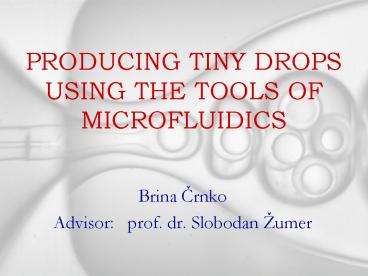PRODUCING TINY DROPS USING THE TOOLS OF MICROFLUIDICS - PowerPoint PPT Presentation
1 / 17
Title:
PRODUCING TINY DROPS USING THE TOOLS OF MICROFLUIDICS
Description:
PRODUCING TINY DROPS USING THE TOOLS OF MICROFLUIDICS. Brina Crnko ... of-principle demonstration) chip, that synthesizes FDG (2'-deoxy-2-[18F]fluoro ... – PowerPoint PPT presentation
Number of Views:44
Avg rating:3.0/5.0
Title: PRODUCING TINY DROPS USING THE TOOLS OF MICROFLUIDICS
1
PRODUCING TINY DROPS USING THE TOOLS OF
MICROFLUIDICS
- Brina Crnko
- Advisor prof. dr. Slobodan Žumer
2
CONTENTS
- Microfluidics
- Definition
- Promises and applications
- Properties of flows in small channels
- Jets and drops
- Mechanism of formation
- Creating drops
- Double emulsions
- Measuring and predicting radii
- New materials
- Conclusion
3
MICROFLUIDICS
- Studying flows in small channels (r50µm).
- Manipulation of small amounts of fluids
(10-9-10-18 l). - 1nl10-9l(100 µm)3
- Main attraction
- lab on a chip
- for biochemical
- applications.
- IDEAL Cheap, small,
- easy-to-use,
- disposable device for
- synthesis and analysis
- (e.g. for blood tests).
4
MICROFLUIDICS
- Example
- Microfluidic (proof-of-principle demonstration)
chip, that synthesizes FDG (2-deoxy-2-18Ffluoro
-D-glucose), a tracer compound used in positron
emission tomography, a medical imaging technique - Introduce reagents through micropipettes into a
network of channels and plumbing, imprinted on - a polymer (PMDS).
- Needed valves, mixers,
- pumps, detectors, filters
- All adapted to peculiar
- properties of flows in small
- channels
5
FLOWS IN MICROCHANNELS
- Reynolds number ratio of inertial to viscous
forces - Water ?103kg/m3, ?10-3kg/ms
- v1µm/s-1cm/s
- L50µm
- Re10-6-10
6
FLOWS IN MICROCHANNELS
- Remember for pipes with smooth walls, flow
becomes turbulent for Regt2000 - For L50µm, flow is laminar for vlt10m/s
- Flow in microchannels is laminar.
- Navier-Stokes
- Nonlinearity is absent (Stokes flow).
- Laminar flow, no turbulence.
- Fluids can flow parallely, no mixing, only
diffusion. - (Mixing has to be achieved otherwise.)
7
JETS AND DROP FORMATION
- Rayleigh-Plateau instability
- A thin jet of water breaks into droplets,
- as the surface energy is lower for drops.
- d(surface energy)? d(area)
- Jet VjetpR2L, Sjet2pRL
- Drops Vdropsn4pr3/3, Sdropsn4pr2,
VdropsVjet - When rgt3R/2, surface energy is lower for drops.
- A cylinder of water in air is unstable.
8
CREATION OF EMULSIONS
- Similar a cylinder of fluid flowing inside a
cylinder of outer fluid (immiscible fluids). - Formation of drops balance between surface
tension and the viscous drag of the fluid pulling
on the drop. - Desired outcome either drops (emulsions) or
jets (ink jet printers).
9
CREATION OF EMULSIONS
- Setup Immiscible fluids (e.g. water and oil)
- Regimes
- Dripping Drops form at the end of
- inner capillary
- Jetting If the speed of one fluid is
increased sufficiently, the result is a
jet, drops form further downstream - ljettpinch off vinterface
- Capillary numberCaviscous drag/surface
tension?v/? - ?viscosity (outer fluid), ?interfacial
tension, vvelocity (inner fluid) - Transition between dripping and jetting Ca1
10
HYDRODYNAMIC FOCUSING
- Flow of the outer fluid focuses the inner fluid
- Creating double emulsion
- e.g. oil-water-oil
- Outer fluid focuses a coaxial stream of middle
and inner fluid. - Drops uniform droplets within larger uniform
drops
11
CREATING DOUBLE EMULSIONS
- Adjust flows and dripping-jetting transitions of
both fluids - create different structures - Control drop diameter, control shell thickness,
control number of inner drops.
12
RADII OF JETS AND DROPS
- QOF...flow rate of the outer fluid
- Qsum...sum of flow rates
- of middle and inner fluids
- Dripping
- Solid circledrop
- diameter
- Open circleinner drop
- diameter
- Half-filled circlejet
- radius
- Jetting
- Solid triangledrop
- diameter
- Open triangleinner
- drop diameter
- Half-filled trianglejet
- radius
13
RADII OF JETS AND DROPS
- Model
- Dripping
- Rjet from the mass flux at the orifice
- Rdrop from Navier-Stokes for a flat profile
- Jetting
- Rdrop from
- Rjet from Navier-Stokes for a parabolic profile
- Model
- Solid linepredicted drop size (dripping)
- Dashed linepredicted drop size (jetting)
- Dotted linepredicted jet radius (flat velocity
profile) - Dash-dotted linepredicted jet radius (parabolic
velocity profile)
14
TRIPLE EMULSIONS
- Cascaded microcapillary devices drops within
drops within drops number and size of all steps
can be controlled.
15
POSSIBLE NEW MATERIALS
- Double emulsion of water-volatile oil with
surfactant-water - Surfactant diblock copolymer or phospholipid
- Surfactant goes to the interfaces, oil evaporates
- Possible encapsulants of drugs etc.
- Add resin (glue) and
- harden (e.g. by UV light)
- solid shells
16
SHELLS OF LIQUID CRYSTALS
- Middle fluid liquid crystal mixed with
chloroform (to ensure isotropy and lower
viscosity) - Chloroform evaporates shell of liquid crystal
- Defect structures can be studied
17
CONCLUSIONS
- Drops could be used as microreactors for chemical
reactions. - Once made, drops can be manipulated in channels,
imprinted in PDMS. - Production of drops and jets with coaxial flows
lead to highly monodisperse emulsions for many
possible applications. - Despite great expectations, commercial
microfluidic devices are very few. - Active field of research, full of imagination,
innovation and promise, but still in its infancy.
As a field, microfluidics is a combination of
unlimited promise, pimples and incomplete
commitment.































